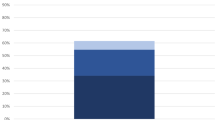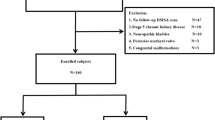Abstract
The purpose of this retrospective cohort study was to report the clinical course of children with primary vesicoureteral reflux (VUR). Between 1970 and 2004, 735 patients were diagnosed with VUR and were systematically followed in a single tertiary renal unit. Patients were followed up for a mean time of 76 months (6 months to 411 months). The events of interest were reflux resolution, renal damage, urinary tract infection (UTI), chronic kidney disease (CKD), and hypertension. Survival analysis was performed in order to evaluate reflux resolution and CKD. Renal damage was detected at admission in 319 patients (43.4%). Continuous low-dose antibiotic prophylaxis was administered to 624 patients (91.2%); 499 (73%) patients subsequently had no UTI or fewer than three episodes. The median time of persistence of reflux according to Kaplan–Meier analysis was 38 months for grade I/II [95% confidence interval (95% CI), 33–43], 98 months for grade III (95% CI, 78.5–105), and 156 months for grade IV/V (95% CI, 122–189). Twenty patients (3%) developed hypertension. It was estimated that the probability of CKD was 5% at 10 years after diagnosis of VUR; for children diagnosed after 1990 the probability of CKD was only 2%. Renal function impairment occurred in patients with severe bilateral reflux or in patients with contralateral renal hypoplasia. There has been an improvement of prognosis for patients diagnosed in the past 15 years.


Similar content being viewed by others
References
Greenfield SP (2003) Vesicoureteral reflux-current treatment options. Expert Opin Pharmacother 4:1959–1966
Sargent MA (2000) What is the normal prevalence of vesicoureteral reflux? Pediatr Radiol 30:587–593
Woodward M, Frank D (2002) Postnatal management of antenatal hydronephrosis. BJU Int 89:149–156
Elder JS (2005) Imaging for vesicoureteral reflux—is there a better way? J Urol 174:7–8
Arant BS Jr (2001) Vesicoureteral reflux and evidence-based management. J Pediatr 139:620–621
Belman AB (1995) A perspective on vesicoureteral reflux. Urol Clin North Am 22:139–150
Edwards D, Normand IC, Prescod N, Smellie JM (1977) Disappearance of vesicoureteric reflux during long-term prophylaxis of urinary tract infection in children. BMJ 2:285–288
Smellie J, Edwards D, Hunter N, Normand IC, Prescod N (1975) Vesico-ureteric reflux and renal scarring. Kidney Int Suppl 4:S65–S72
Elder JS, Peters CA, Arant BS Jr, Ewalt DH, Hawtrey CE, Hurwitz RS, Parrott TS, Snyder HM 3rd, Weiss RA, Woolf SH, Hasselblad V (1997) Pediatric Vesicoureteral Reflux Guidelines Panel summary report on the management of primary vesicoureteral reflux in children. J Urol 157:1846–1851
Lebowitz RL, Olbing H, Parkkulainen KV, Smellie JM, Tamminen-Mobius TE (1985) International system of radiographic grading of vesicoureteric reflux. International reflux study in children. Pediatr Radiol 15:105–109
Filgueiras MF, Lima EM, Sanchez TM, Goulart EM, Menezes AC, Pires CR (2003) Bladder dysfunction: diagnosis with dynamic US. Radiology 227:340–344
Koff SA, Wagner TT, Jayanthi VR (1998) The relationship among dysfunctional elimination syndromes, primary vesicoureteral reflux and urinary tract infections in children. J Urol 160:1019–1022
Silva JM, Oliveira EA, Diniz JS, Cardoso LS, Vergara RM, Vasconcelos MA, Santo DE (2006) Gender and vesico-ureteral reflux: a multivariate analysis. Pediatr Nephrol 21:510–516
Schwartz GJ, Brion LP, Spitzer A (1987) The use of plasma creatinine concentration for estimating glomerular filtration rate in infants, children, and adolescents. Pediatr Clin North Am 34:571–590
No authors listed (1987) Report of the second task force on blood pressure control in children - 1987. Task force on blood pressure control in children. National Heart, Lung, and Blood Institute, Bethesda, Maryland. Pediatrics 79:1–25
National High Blood Pressure Education Program Working Group on High Blood Pressure in Children and Adolescents (2004) The fourth report on the diagnosis, evaluation, and treatment of high blood pressure in children and adolescents. Pediatrics 114 Suppl 2:555–576
Skoog SJ, Belman AB, Majd M (1987) A nonsurgical approach to the management of primary vesicoureteral reflux. J Urol 138:941–946
Weiss R, Tamminen-Mobius T, Koskimies O, Olbing H, Smellie JM, Hirche H, Lax-Gross H (1992) Characteristics at entry of children with severe primary vesicoureteral reflux recruited for a multicenter, international therapeutic trial comparing medical and surgical management. The International Reflux Study in Children. J Urol 148:1644–1649
Goldraich NP, Goldraich IH (1992) Follow up of conservatively treated children with high and low grade vesicoureteral reflux: a prospective study. J Urol 148:1688–1692
Chen JJ, Mao W, Homayoon K, Steinhardt GF (2004) A multivariate analysis of dysfunctional elimination syndrome, and its relationships with gender, urinary tract infection and vesicoureteral reflux in children. J Urol 171:1907–1910
Chandra M, Maddix H (2000) Urodynamic dysfunction in infants with vesicoureteral reflux. J Pediatr 136:754–759
Smellie JM, Prescod NP, Shaw PJ, Risdon RA, Bryant TN (1998) Childhood reflux and urinary infection: a follow-up of 10–41 years in 226 adults. Pediatr Nephrol 12:727–736
Risdon RA (1993) The small scarred kidney in childhood. Pediatr Nephrol 7:361–364
Wennerstrom M, Hansson S, Jodal U, Stokland E (2000) Primary and acquired renal scarring in boys and girls with urinary tract infection. J Pediatr 136:30–34
Yeung CK, Godley ML, Dhillon HK, Gordon I, Duffy PG, Ransley PG (1997) The characteristics of primary vesico-ureteric reflux in male and female infants with pre-natal hydronephrosis. Br J Urol 80:319–327
Lama G, Russo M, De Rosa E, Mansi L, Piscitelli A, Luongo I, Esposito Salsano M (2000) Primary vesicoureteric reflux and renal damage in the first year of life. Pediatr Nephrol 15:205–210
Silva JM, Diniz JS, Vergara RM, Lima EM, Oliveira EA (2006) Predictive factors of resolution of primary vesicoureteral reflux: a multivariate analysis. BJU Int 97:1063–1068
Sjostrom S, Sillen U, Bachelard M, Hansson S, Stokland E (2004) Spontaneous resolution of high grade infantile vesicoureteral reflux. J Urol 172:694–698
No authors given (1983) Prospective trial of operative versus non-operative treatment of severe vesicoureteric reflux: two years’ observation in 96 children. Br Med J (Clin Res Ed) 287:171–174
Smellie JM, Tamminen-Mobius T, Olbing H, Claesson I, Wikstad I, Jodal U, Seppanen U (1992) Five-year study of medical or surgical treatment in children with severe reflux: radiological renal findings. The International Reflux Study in Children. Pediatr Nephrol 6:223–230
Weiss R, Duckett J, Spitzer A (1992) Results of a randomized clinical trial of medical versus surgical management of infants and children with grades III and IV primary vesicoureteral reflux (United States). The International Reflux Study in Children. J Urol 148:1667–1673
Schwab CW Jr, Wu HY, Selman H, Smith GH, Snyder HM 3rd, Canning DA (2002) Spontaneous resolution of vesicoureteral reflux: a 15-year perspective. J Urol 168:2594–2599
Smellie JM, Jodal U, Lax H, Mobius TT, Hirche H, Olbing H (2001) Outcome at 10 years of severe vesicoureteric reflux managed medically: Report of the International reflux study in children. J Pediatr 139:656–663
Jacobson SH, Eklof O, Eriksson CG, Lins LE, Tidgren B, Winberg J (1989) Development of hypertension and uraemia after pyelonephritis in childhood: 27 year follow up. BMJ 299:703–706
Zhang Y, Bailey RR (1995) A long term follow up of adults with reflux nephropathy. N Z Med J 108:142–144
Gusmano R, Perfumo F (1993) Worldwide demographic aspects of chronic renal failure in children. Kidney Int Suppl 41:S31–S35
Jones KV (1999) Prognosis for vesicoureteric reflux. Arch Dis Child 81:287–289
Farnham SB, Adams MC, Brock JW 3rd, Pope JCT (2005) Pediatric urological causes of hypertension. J Urol 173:697–704
Wallace DM, Rothwell DL, Williams DI (1978) The long-term follow-up of surgically treated vesicoureteric reflux. Br J Urol 50:479–484
Fanos V, Cataldi L (2004) Antibiotics or surgery for vesicoureteric reflux in children. Lancet 364:1720–1722
Wheeler D, Vimalachandra D, Hodson EM, Roy LP, Smith G, Craig JC (2003) Antibiotics and surgery for vesicoureteric reflux: a meta-analysis of randomised controlled trials. Arch Dis Child 88:688–694
Acknowledgments
This study was partially supported by CNPq (Brazilian National Research Council) and Pró-Reitoria de Pesquisa (UFMG). M.A.V. was a recipient of the CNPq fellowship.
Author information
Authors and Affiliations
Corresponding author
Rights and permissions
About this article
Cite this article
Silva, J.M.P., Santos Diniz, J.S., Marino, V.S.P. et al. Clinical course of 735 children and adolescents with primary vesicoureteral reflux. Pediatr Nephrol 21, 981–988 (2006). https://doi.org/10.1007/s00467-006-0151-1
Received:
Revised:
Accepted:
Published:
Issue Date:
DOI: https://doi.org/10.1007/s00467-006-0151-1




